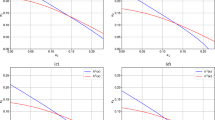Abstract
A completely dependent risk process with perturbation and phase-type distributed claim sizes is analyzed. Claim arrivals are modeled by a Markovian arrival process. Using a vector-valued martingale, the Laplace transform of the time to ruin is derived algorithmically. The conditional memoryless property of the phase-type distribution yields the distribution of the deficit at ruin as a corollary.
Zusammenfassung
Wir untersuchen einen perturbierten Risikoprozess mit stochastisch abhängigen Schadenszeiten und -forderungen. Erstere werden durch einen Markovschen Ankunftsprozess (MAP) modelliert, die Höhe der letzteren durch Verteilungen vom Phasentyp. Mittels eines vektorwertigen Martingals wird die Laplace-Transformierte der Ruinzeit bestimmt. Die bedingte Gedächtnislosigkeit der Phasentypverteilung ermöglicht dann auch die Bestimmung der Defizitverteilung zum Ruinzeitpunkt.
Similar content being viewed by others
References
Gerber HU (1970) An extension of the renewal equation and its application in the collective theory of risk. Skandinavisk Aktuarietidskrift 53:205–210
Dufresne F, Gerber HU (1991) Risk theory for the compound Poisson process that is perturbed by diffusion. Insurance: Math Econ 10:51–59
Schmidli H (1995) Cramer–Lundberg approximations for ruin probabilities of risk processes perturbed by diffusion. Insurance: Math Econ 16:135–149
Gerber HU, Landry B (1998) On a discounted penalty at ruin in a jump-diffusion and the perpetual put option. Insurance: Math Econ 22:263–276
Wang G (2001) A decomposition of the ruin probability for the risk process perturbed by diffusion. Insurance: Math Econ 28:49–59
Tsai CCL (2003) On the expectations of the present values of the time of ruin perturbed by diffusion. Insurance: Math Econ 32:413–429
Chiu SN, Yin CC (2003) The time of ruin, the surplus prior to ruin and the deficit at ruin for the classical risk process perturbed by diffusion. Insurance: Math Econ 33(1):59–66
Li S (2006) The distribution of the dividend payments in the compound poisson risk model perturbed by diffusion. Scand Actuarial J 2:73–85
Li S, Garrido J (2005) The Gerber–Shiu function in a Sparre Andersen risk process perturbed by diffusion. Scand Actuarial J 3:161–186
Gerber HU, Shiu ESW (1998) On the time value of ruin. North Am Actuarial J 2(1):48–78
Albrecher H, Boxma OJ (2005) On the discounted penalty function in a Markov-dependent risk model. Insurance: Math Econ 37(3):650–672
Lu Y, Li S (2005) On the probability of ruin in a Markov-modulated risk model. Insurance: Math Econ 37:522–532
Lu Y (2006) On the severity of ruin in a Markov-modulated risk model. Scand Actuarial J 4:183–202
Asmussen S (2000) Ruin Probabilities. Singapore: World Scientific
Badescu AL, Breuer L, Da Silva Soares A, Latouche G, Remiche M-A, Stanford D (2005a) Risk processes analyzed as fluid queues. Scand Actuarial J 2:127–141
Badescu AL, Breuer L, Drekic S, Latouche G, Stanford D (2005b) The surplus prior to ruin and the deficit at ruin for a correlated risk process. Scand Actuarial J 6:433–445
Ramaswami V (2006) Passage times in fluid models with application to risk processes, Methodol Computing Appl Probab 8(4):497–515
Ahn S, Badescu AL (2007) On the analysis of the Gerber–Shiu discounted penalty function for risk processes with Markovian arrivals. Insurance: Math Econ 41(2):234–249
Neuts MF (1979) A versatile Markovian point process. J Appl Probab 16:764–779
Asmussen S (1995) Fluid flow models with or without Brownian motion. Stoch Models 11:1–20
Asmussen S, Kella O (2000) Multi-dimensional matringales. Adv Appl Prob 32:376–393
Gershgorin S (1931) Über die Abgrenzung der Eigenwerte einer Matrix. Izv Akad Nauk USSR Otd Fiz-Mat Nauk 7:749–754
Latouche G, Ramaswami V (1999) Introduction to Matrix Analytic Methods in Stochastic Modeling. Philadelphia: ASA SIAM
De Smit JHA (1983) The queue GI/M/s with customers of different types or the queue GI/Hm/s. Adv Appl Probab 15:392–419
De Smit JHA (1995) Explicit Wiener–Hopf factorization for the analysis of multi-dimensional queues. Advances in Queueing: Theory, Methods and Open Problems, JH Dshalalow, CRC Press, Boca Raton
Gaver D (1966) Observing stochastic processes, and approximate transform inversion. Operations Res 14(3):444–459
Stehfest H (1970) Numerical inversion of Laplace transforms. Commun ACM 13(1):45–47
Author information
Authors and Affiliations
Corresponding author
Rights and permissions
About this article
Cite this article
Badescu, A., Breuer, L. The use of vector-valued martingales in risk theory . Blätter DGVFM 29, 1–12 (2008). https://doi.org/10.1007/s11857-008-0049-z
Received:
Revised:
Accepted:
Published:
Issue Date:
DOI: https://doi.org/10.1007/s11857-008-0049-z




